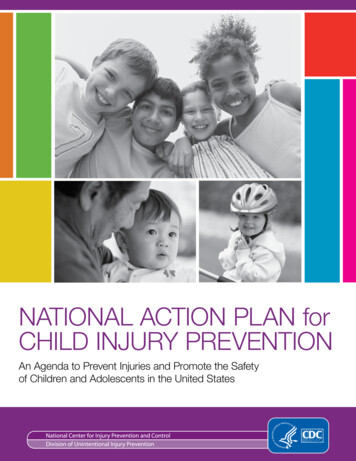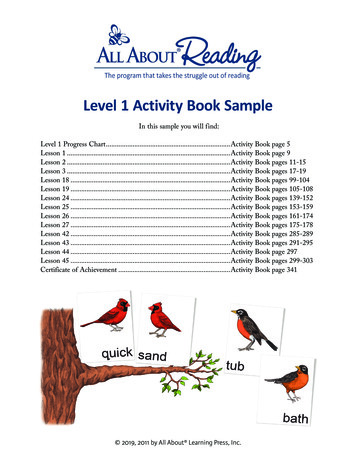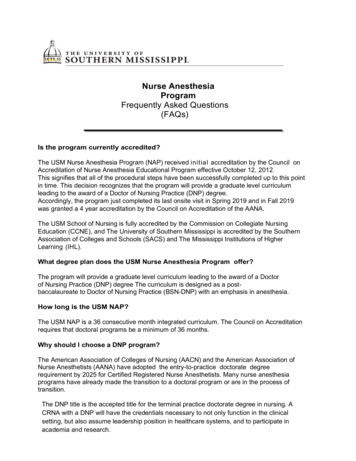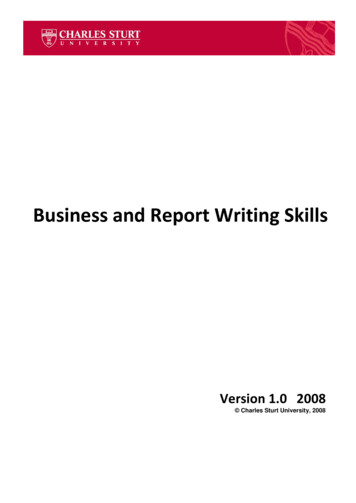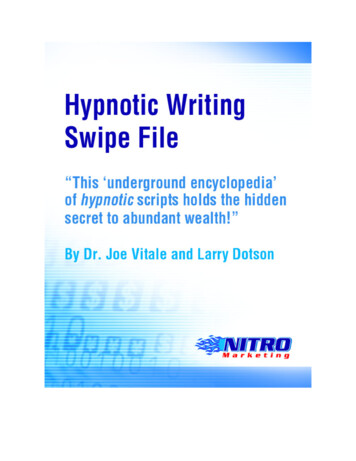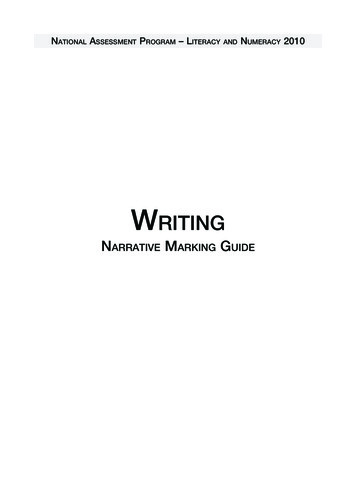
Transcription
National Assessment Program – LiteracyandNumeracy 2010WritingNarrative Marking Guide
2
CONTENTSCriteria6Annotated exemplars16Discussion scripts72Additional information76Glossary of grammatical items78Spelling reference list833
Assessing Writing in the National Assessment ProgramThe writing taskThe writing task for this test is a narrative. It is the same task for all students in Years 3, 5, 7 and 9.The administration of the writing tasks employs closely scripted scaffolding. The teacher reads the directions on thewriting prompt aloud to all students. The prompt includes images which can support students in crafting their response.Students have 5 minutes to plan, 30 minutes to write and 5 minutes to edit.DefinitionThe following definition of the social purposes of the narrative has shaped the development of the criteria. It has alsoshaped the delineation of the essential structural components required for the task.A narrative is a time-ordered text that is used to narrate events and to create, entertain and emotionally move anaudience. Other social purposes of narrative writing may be to inform, to persuade and to socialise. The main structuralcomponents of a narrative are the orientation, the complication and the resolution.CriteriaThe ten criteria assessed in the writing task are:1.Audience – The writer’s capacity to orient, engage and affect the reader2.Text structure – The organisation of narrative features including orientation, complication and resolution into anappropriate and effective text structure3.Ideas – The creation, selection and crafting of ideas for a narrative4.Character and setting – Character: The portrayal and development of characterSetting:The development of a sense of place, time and atmosphere5.Vocabulary – The range and precision of language choices6.Cohesion – The control of multiple threads and relationships over the whole text, achieved through the use ofreferring words, substitutions, word associations and text connectives7.Paragraphing – The segmenting of text into paragraphs that assists the reader to negotiate the narrative8.Sentence structure – The production of grammatically correct, structurally sound and meaningful sentences9.Punctuation – The use of correct and appropriate punctuation to aid reading of the text10. Spelling – The accuracy of spelling and the difficulty of the words used.The following table shows criteria and the range of score points for the writing task.AudienceTextstructureIdeasCharacterand PunctuationSpelling0 –60–40–50–40–50–40–20–60–50–64
Using this marking guideThe top of each page shows the criterion name and number. The skill focus defines the underlying skillbeing assessed.The category descriptor is a broad statement describing the particular skill level. This is an overall statement thatshould be used to make the judgement.Additional information is included to help shape the judgement. However, this information should not be readas an exhaustive list.Notes at the bottom of the page provide clarifying detail where necessary.Sample scripts which exemplify the standard for a particular score are listed. (The number in brackets is the pagereference.) The script and annotations supporting the score are organised in the middle section of the markingguide.A glossary of terms used in the rubric is provided after the exemplars.A list of spelling words is included at the back of the guide. This list should be used in conjunction with thespelling criterion on page 15. The list is not exhaustive.Before beginning the Writing test, all students are given a coloured Writing test stimulus sheet and are read thefollowing instructions:Today you will do a Writing test.In this test you are going to write a narrative. Narratives are also called stories.You have to write a story about the topic. You can use the ideas from this stimulus sheet or you can useyour own ideas about this. Look at the pictures and the words to help you with your ideas.During marking in 2010, information will be collected on whether students have written on the assigned topic. Thiswill be done by markers recording a 0 or 1 against the criterion. Comprehensive training on how to assess whethera student has written on topic or not will be provided to all markers in all Australian marking centres prior to thecommencement of marking.5
1AudienceSkill focus: The writer’s capacity to orient, engage and affect the reader.Category descriptorAdditional informationSample scripts0– s ymbols or drawings whichhave the intention ofconveying meaningRole-play writer (16)1–c ontains some simplewritten contentDungaun (17)2– s hows awareness of basicaudience expectationsthrough the use of simplenarrative markersSimple narrative markers mayinclude:– simple titles– formulaic story opening:Long, long ago Once a boy was walkingwhen – description of people or placesThe casel (19)BMX (21)My Story (23)Living dead (25)3–a n internally consistent storythat attempts to support thereader by developing a sharedunderstanding of context–c ontains sufficient informationfor the reader to follow the storyfairly easilyWoodern box (27)One sunny morning (29)October 16, 1981 (33)Zip (35)The shade whispered (75)4– s upports reader understanding– attempts to engage the readerNarrative devices may include:– fantasy, humour, suspense– sub-genre styles (e.g. satire,boys’ own, chick lit)– intertextual referencesSpace Tour (39)The haunted house (41)Gambat (45) 5– s upports and engages thereader through deliberatechoice of language and useof narrative devices6 – c aters to the anticipatedvalues and expectationsof the reader– influences or affects thereader through precise andsustained choice of languageand use of narrative devicesLanguage choices may:– control writer/reader relationship– reveal values and attitudes– establish narrator stance– subvert expectations– evoke an emotional response– encourage reflection– display irony6Tracy (47)Best friends (51)Lovely purple boots (55)The Water Tower (59)In the distance (63)Axe (67)The Deep Blue Nothing (71)
2Text structureSkill focus: The organisation of narrative features including orientation, complication and resolution into anappropriate and effective text structure.Category descriptorAdditional informationSample scripts0–n o evidence of any structuralcomponents of atime-sequenced text– symbols or drawings– inappropriate genre, eg a recipeRole-play writer (16)1–m inimal evidence of narrativestructure, eg a story beginningonly or a ‘middle’ with noorientation– a recount of events withno complication–n ote that not all recounts arefactualDungaun (17)The casel (19)BMX (21)Zip (35)Space Tour (39)2–c ontains a beginning anda complication– where a resolution is presentit is weak, contrived or‘tacked on’ (e.g. I woke up,I died, They lived happilyever after)–A complication presents a problemto be solved, introduces tension,and requires a response.It drives the story forward andleads to a series of events orresponses.– Complications should alwaysbe read in context.– may also be a complete storywhere all parts of the story areweak or minimal (The story hasa problem to be solved but itdoes not add to the tension orexcitement.)My Story (23)Living dead (25)Woodern box (27)One sunny morning (29)The shade whispered (75)3–c ontains orientation,complication and resolution– detailed longer text mayresolve one complication andlead into a new complicationor layer a new complicationonto an existing one ratherthan concludeSophisticated structuresor plot devices include:October 16, 1981 (33)The haunted house (41)Gambat (45)Tracy (47)Best friends (51)Lovely purple boots (55)– foreshadowing/flashback– red herring/cliffhanger4–c oherent, controlled andcomplete narrative, employingeffective plot devices in anappropriate structure, andincluding an effective ending– coda/twist– evaluation/reflection– circular/parallel plots7The Water Tower (59)In the distance (63)Axe (67)The Deep Blue Nothing (71)
3IdeasSkill focus: The creation, selection and crafting of ideas for a narrative.Category descriptorAdditional informationSample scripts0–n o evidence or insufficientevidence– symbols or drawingsRole-play writer (16)1– i deas are very few and verysimple– ideas appear unrelatedDungaun (17)The casel (19)BMX (21)2– i deas are few, not elaboratedor very predictableMy Story (23)Living dead (25)3– i deas show some developmentor elaboration– all ideas relate coherentlyto a central storyline4– i deas are substantial andelaborated– ideas effectively contributeto a central storyline– the story contains asuggestion of an underlyingtheme5– i deas are generated, selectedand crafted to explore arecognisable theme– ideas are skilfully used in theservice of the storyline– s ome ideas may containunnecessary elaboration (waffle)Woodern box (27)One sunny morning(29)October 16, 1981 (33)Zip (35)Space Tour (39)The haunted house (41)Tracy (47)The shade whispered (75)Gambat (45)Best friends (51)Ideas may include:– psychological subjects– unexpected topics– mature viewpoints– elements of popular culture– satirical perspectives– extended metaphor– traditional sub-genre subjects:heroic questwhodunnitgood vs evilovercoming the odds8Lovely purple boots (55)The Water Tower (59)In the distance (63)Axe (67)The Deep Blue Nothing (71)
4Character and settingSkill focus: Character: The portrayal and development of character.Setting: The development of a sense of place, time and atmosphere.Category descriptorAdditional informationSample scripts0–n o evidence or insufficientevidence– symbols or drawingsRole-play writer (16)1–o nly names characters or givestheir roles (e.g. father, theteacher, my friend, dinosaur,we, Jim)AND/OR– only names the setting: (e.g.school, the place we were at)Setting is vague or confused2– s uggestion of characterisationthrough brief descriptions orspeech or feelings, but lackssubstance or continuityAND/OR– suggestion of setting throughvery brief and superficialdescriptions of place and/ortime3–c haracterisation emergesthrough descriptions, actions,speech or the attribution ofthoughts and feelings to acharacterAND/OR– setting emerges throughdescription of place, timeand atmosphere4–e ffective characterisation.Details are selected to createdistinct characters.AND/OR– maintains a sense of settingthroughout. Details areselected to create a senseof place and atmosphere.Dungaun (17)The casel (19)BMX (21)–b asic dialogue or a few adjectivesto describe a character or a placeMy Story (23)Living dead (25)One sunny morning (29)October 16, 1981 (33)Space Tour (39)Woodern box (27)Zip (35)The haunted house (41)Gambat (45)Tracy (47)The shade whispered (75)–c onvincing dialogue, introspectionand reactions to other charactersBest friends (51)Lovely purple boots (55)The Water Tower (59)In the distance (63)Axe (67)The Deep Blue Nothing (71)NOTESCharacterisation and setting are essential components of effective narrative writing. The inclusion of the AND/OR category isnecessary as different types of stories may focus on only one aspect.Some stories may be character-driven (e.g. Pippi Longstocking by Astrid Lindgren) and the setting may be very sketchy orundeveloped. Other stories, which attempt to build atmosphere and suspense, may focus on setting the scene (e.g. the wildwest genre) with little character detail. Many stories will have a balance of these two components.9
5VocabularySkill focus: The range and precision of language choices.Category descriptorAdditional informationSample scripts0– symbols or drawings1– very short scriptfew content wordsDungaun (17)BMX (21)2–m ostly simple verbs, adverbs,adjectives or nouns– s ingle words: quick, big, run,look, red, cold, water, great, man,soft, need, really, very, beautiful,scream, grab, huge, think– simple groups: My big warm bed;It looked like a bright green lizard;A five headed, six armed monster– simple figurative language: as bigas a houseThe casel (19)My Story (23)Living dead (25)Woodern box (27)One sunny morning (29)October 16, 1981 (33)– s ingle precise words: hissed,yanked, clutched, absolutely,disgusted, exhilarating, rewarded,eventually– effective simile: into a porthole-like trap; Burningcoal shot out like tiny bullets– metaphor: lungs screamedfor air– attitudinal: simpered– evaluative: devout, aggressive,hard-done by– technical: resuscitated– formal: To what do I owe thishonour?– colloquial language for characters’speech: Watcha doin?– alliteration: completelycaptivating cat called Clarence– effective personification the windclutched at her hairZip (35)Space Tour (39)The haunted house (41)The shade whispered (75)–m ay include two or threeprecise words3–p recise words or word groups(may be verbs, adverbs,adjectives or nouns)4– s ustained and consistent useof precise words and phrasesthat enhance the meaning ormood5–a range of precise andeffective words and phrasesused in a natural and articulatemannerLanguage choice is wellmatched to genre.Role-play writer (16)Gambat (45)Tracy (47)Best friends (51)Lovely purple boots (55)The Water Tower (59)In the distance (63)Axe (67)The Deep Blue Nothing (71)NOTESWords are generally categorised into two classes:Content words (or lexical items) describe objects and concepts. This class of words consists of nouns, verbs, adverbs,adjectives, noun groups, phrasal verbs and verb groups.Grammatical word classes (or structural words) consist of prepositions, articles, conjunctions, pronouns and interjections.10
6CohesionSkill focus: The control of multiple threads and relationships over the whole text, achieved through the useof referring words, substitutions, word associations and text connectives.Category descriptorAdditional informationSample scripts0– symbols or drawingsRole-play writer (16)1– l inks are missing or incorrect– short scriptDungaun (17)The casel (19)BMX (21)Often confusing for the reader.2– s ome correct links betweensentences (do not penalisefor poor punctuation)– most referring words areaccurateReader may occasionally needto re-read and provide theirown links to clarify meaning.– s mall selection of simpleconnectives and conjunctionsused: then, soon, and, but, or,then, suddenly, so, and then,when, ordinal numbers, onlytemporal connectives– often marked by cumbersomerepetition of nouns or unreferencedpronounsMy Story (23)Living dead (25)Woodern box (27)One sunny morning (29)October 16, 1981 (33)Zip (35)3–c ohesive devices are usedcorrectly to support readerunderstanding– accurate use of referringwordsMeaning is clear and text flowswell in a sustained piece ofwriting.–o ther connectives used: later,meanwhile, instead, in themiddle of, earlier, just as, usually,although, even though, such as,because, finally– word association to avoidrepetition, eg synonyms, antonyms,word sets,control of narrative tenseSpace Tour (39)The haunted house (41)Gambat (45)Tracy (47)Best friends (51)The shade whispered (75)4–a range of cohesive devices isused correctly and deliberatelyto enhance readingAn extended, highly cohesivepiece of writing showingcontinuity of ideas and tightlylinked sections of text.–c onsistent use of word associationsand substitutions that enhancereadingLovely purple boots (55)The Water Tower (59)In the distance (63)Axe (67)The Deep Blue Nothing (71)11
7ParagraphingSkill focus: The segmenting of text into paragraphs that assists the reader to negotiate the narrative.Category descriptorAdditional information0no use of paragraphing––––1writing is organised intoparagraphs that are mainlyfocused on a single idea orset of like ideas that assist thereader to digest chunks of text–p aragraphs used to separate theintroduction or conclusion from thebody of the narrative (2 paragraphs)– paragraphs used to mark formulaicnarrative structure (beginning,middle and end).– indicates broad changes intime and scene or time orderedstructureOctober 16, 1981 (33)Zip (35)Space Tour (39)The haunted house (41)Gambat (45)Tracy (47)The shade whispered (75)2all paragraphs are focused onone idea or set of like ideas andenhance the narrative–d eliberately structured to pace anddirect the reader’s attention– single sentence may be used as adramatic or final comment or foremphasisBest friends (51)Lovely purple boots (55)The Water Tower (59)In the distance (63)Axe (67)The Deep Blue Nothing (71)s cript is a block of text random breaks new line for every sentence new line for new speaker with noother paragraphing evidentSample scriptsRole-play writer (16)Dungaun (17)The casel (19)BMX (21)My Story (23)Living dead (25)Woodern box (27)One sunny morning (29)NOTESFor the purposes of the task, paragraphing can be indicated by any of the following conventions: indentation of a new line space between blocks of text student annotations, eg P for paragraph, tram lines, square brackets, asterisk available space on previous line left unused, followed by new line for paragraph beginning.12
8Sentence structureSkill focus: The production of grammatically correct, structurally sound and meaningful sentences.Category descriptorAdditional informationSample scripts0– no evidence of sentences–d rawings, symbols, a list of words,text fragmentsRole-play writer (16)1– s ome correct formation ofsentencesSome meaning can be construed.– in general, control is very limitedDungaun (17)The casel (19)BMX (21)2–m ost simple sentences arecorrectMeaning is predominantly clear.–c orrect sentences arepredominantly simpleMy Story (23)Living dead (25)3–m ost simple and compoundsentences correct– some complex sentences arecorrectMeaning is predominantly clear.– experiments with complexityWoodern box (27)One sunny morning (29)October 16, 1981 (33)The shade whispered (75)4– s imple and compound sentencesare correct– most complex sentences arecorrectORAll sentences correct but do notdemonstrate varietyMeaning is clear.–g reater control of complexsentences but lacks variety– allow for an occasional ‘typo’ insimple or compound sentencesZip (35)Space Tour (39)The haunted house (41)Gambat (45)Tracy (47)Lovely purple boots (55)5– s entences correct (allow foroccasional typo, eg a missingword)– demonstrates variety in length,structure and beginningsMeaning is clear and sentencesenhance meaning.VARIETY– clause types and patterns(verbless, adjectival, adverbial,multiple dependencies, non-finite)– dependent clause positionBest friends (51)Axe (67)6– all sentences are correctWriting contains controlled andwell-developed sentences thatexpress precise meaning and areconsistently effective.– l ength and rhythm– lexical density: increased withelaborating and extending phrases,or reduced to the essential– stylistically appropriate choicesThe Water Tower (59)In the distance (63)The Deep Blue Nothing (71)NOTES Some students do not accurately identify their sentence boundaries with punctuation. In these cases it will be necessaryto read the intended sentence. Run-on sentences should not be regarded as successful (overly repeated ‘and’, ‘so’ etc). Verb control and preposition errors should be considered as sentence errors.13
9PunctuationSkill focus: The use of correct and appropriate punctuation to aid reading of the text.NOTE: ‘ Splice’ commas used to join two sentences are INCORRECT. (E.g. The dog ate my homework,it was hungry.) Do not score these as correct sentence punctuation or comma use.Category descriptorAdditional informationSample scripts0–n o evidence of correctpunctuationRole-play writer (16)Dungaun (17)The casel (19)1– s ome correct use of capitalletters to start sentences ORfull stops to end sentencesPunctuation is minimal and oflittle assistance to the reader.Sentence punctuation includes:– capital letters to begin sentences– full stops to end sentences– question marks to end sentences– exclamation marks to end sentences2– s ome accurately punctuatedsentences (beginning and end)– some noun capitalisationwhere applicableProvides some markers toassist reading.3– s ome correct punctuationacross categories (sentencesmostly correct with some otherpunctuation correct)OR– accurate sentence punctuationwith no stray capitals, nothingelse usedProvides adequate markersto assist reading.4–a ll sentence punctuationcorrect– mostly correct use of otherpunctuationProvides accurate markersto enable smooth and efficientreading.5writing contains accurate useof all applicable punctuationProvides precise markersto pace and control readingof the text.Noun capitalisation includes:– first names and surnames– titles: Mr, Mrs, Miss, Ms etc.– place names: Paris, Italy– institution names: Valley High– days of week, months of year– street names: Ord St– book and film titles– holidays: Easter, Ramadan– historic events: World War IIOther punctuation includes:– apostrophes to mark contractions– commas in lists– commas to mark clauses/phrases– apostrophes to mark possession– correct hyphenation of compoundwords– quotation marks for direct speech– capital letters and commas usedwithin quotation marks– new line for each speaker– quotation marks for text extractsand highlighted words– brackets and dashes– brackets to signal humorous asides– colons and semicolons– points of ellipsis– commas or semicolons to balanceor create rhythm between clausesBMX (21)My Story (23)Living dead (25)Woodern box (27)One sunny morning (29)October 16, 1981 (33)Gambat (45)The shade whispered (75)Space Tour (39)The haunted house (41)Zip (35)Tracy (47)Best friends (51)The Water Tower (59)Axe (67)Lovely purple boots (55)In the distance (73)The Deep Blue Nothing (71)NOTESIn first draft writing, allowances can be made for the very occasional omission of sentence punctuation at scores 4 and 5.‘Mostly’ is approximately 80% but it is not intended that every use of punctuation is calculated rigorously.14
10SpellingSkill focus: The accuracy of spelling and the difficulty of the words used.Category descriptorAdditional informationSample scripts0no conventional spellingRole-play writer (16)1few examples of conventionalspelling2correct spelling of– most simple words– some common words(errors evident in commonwords)Simple wordsShort vowel single-syllable words (bad, fit, not) with:– consonant digraphs (shop, thin, much, chips)– consonant blends (drop, clap, grass, bring)– double final consonants (will, less)High frequency long vowel single-syllable words (name,park, good, school, feet, food)3correct spelling of– most simple words– most common words4correct spelling of– simple words– most common words– some difficult words(errors do not outnumbercorrect spellings)5correct spelling of– simple words– most common words– at least 10 difficult words(errors do not outnumbercorrect spellings)6correct spelling of– all words– at least 10 difficult words– some challenging wordsNOTE: As the work is firstdraft writing, allowances canbe made for very occasional(1 or 2) minor errors, whichshould be disregarded whenassigning this category.Common wordsSingle-syllable words with:– harder two consonant blends (crack, square)– three consonant blends (stretch, catch, strung)– common long vowels (face, sail, eight, mean, nice,fly, coke, use, close, again)Multisyllabic words with even stress patterns (middle,litter, plastic, between, hospital)Compound words (downstairs)Common homophones (there/their, write/right, hear/here, brake/break)Suffixes that don’t change the base word (jumped,sadly, adults, happening)Common words with silent letters (know, wrong, comb)Single-syllable words ending in ould, ey, oughMost rule-driven words: drop e, double letter, changey to i (having, spitting, heavier)Difficult wordsUneven stress patterns in multisyllabic words(chocolate, mineral) Uncommon vowel patterns (drought, hygiene) Difficult subject-specific content words (obese) Difficult homophones (practice/practise)Suffixes where base word changes (generate/generation) Consonant alternation patterns (confident/confidence) Many three and four syllable words (invisible, organise,community) Multisyllabic words ending in tion, sion, ture, ible/able,ent/ant, fulChallenging words Unusual consonant patterns (guarantee) Longer words with unstressed syllables (responsibility) Vowel alteration patterns (brief to brevity, propose toproposition) Foreign words Suffixes to words ending in e, c or l (physically,changeable, mathematician)15Dungaun (17)The casel (19)BMX (21)My Story (23)Woodern box (27)Living dead (25)One sunny morning(29)The shadewhispered (75)October 16,1981 (33)Zip (35)The hauntedhouse (41)Tracy (47)Lovely purpleboots (55)Space Tour (39)Gambat (45)Best friends (51)In the distance (63)Axe (67)The Water Tower(59)The Deep BlueNothing (71)
Role-play writerCriterionScoreAnnotations1. Audience0Writing consists of symbols or drawings with the intentionof conveying meaning.2. Text structure0Writing contains no evidence of any structural componentsof a time-sequenced text.3. Ideas0Cannot be read.4. Character/setting0Cannot be read.5. Vocabulary0No discernible words.6. Cohesion0Cannot be read.7. Paragraphing0No paragraphing.8. Sentence structure0Cannot be read.9. Punctuation0No punctuation marks. Mostly capital letters.10. Spelling0Uses letters but no conventional spelling can be discerned.Possibly a string of initial sounds, but decoding is not possible.16
Dungaunscardie bones suddenly i see a bonein the dungeon head bone.I got out the dungeonand I went home and i went fishingwith my uncle to forsterCriterionScoreAnnotations1. Audience1Writing conveys some simple written content.2. Text structure1Very weak sense of narrative structure. I got out the dungaungives some feeling of escape.Elements of recount: I went I went 3. Ideas1Ideas are unrelated. The story begins with bones in a dungeon,followed by a tangential shift to fishing.4. Character/setting1Character and setting only named: uncle, dungaun.5. Vocabulary1Writing contains a limited number of simple and everyday contentwords: got, see, home, head, bone, fishing, dungeon, uncle.6. Cohesion1Basic pronouns used correctly: I, my. Needs significantre-reading to make sense.7. Paragraphing0A block of text with random spacing.8. Sentence structure1Some meaning can be construed.Shows some evidence of basic sentence construction: I see abone in the dungaun; as well as some incomplete sentences: Igot out the dungaun.9. Punctuation0No evidence. An ambiguous mark at the end.10. Spelling1Few examples of mostly simple words: in, a, I, out, the, my,went, got, and, see.Errors: bone, dungeon, home, with, headSome words cannot be clearly interpreted: seeord, seidre.17
The casel18
The caselCriterion1. AudienceScore2AnnotationsShows an awareness of the audience by using simple storymarkers.Has a simple, formulaic story opening and recognisable storycharacters (queen, king, Rapunzel) and setting (castle).Uses a simple title.2. Text structure1Story beginning followed by fairly confusing recount of events.No discernible complication.3. Ideas1Main idea is that the sister has to be asked something.The audience do not find out what this is.4. Character/setting1Characters and setting are named.5. Vocabulary2No precise words but more than a few content words.6. Cohesion1Often confusing for the reader. Requires significantre-reading.7. Paragraphing0No paragraphs indicated.8. Sentence structure1Some correct formation of sentences:Once upon a time there lived a king and queen who hada daughter and a son.I need to tell you something.I will get my sister for you.A king came and knocked on the door.Many errors, missing words and run-on sentences.9. Punctuation0No punctuation evident.10. Spelling2Simple: king, had, in, and, the, can, tell, get, go, you, she,on, sing, willCommon: joke, time, your, said, sister, talk, live, after, doorErrors: castle, queen, something, funny, who, son, came,lived, knocked19
The casel – TRANSLATION20
BMXCriterionScoreAnnotations1. Audience2Provides some simple content that is a section of a story only.No context is established for the audience, no explanation isgiven of who ‘we’ are.2. Text structure1A very brief recount which does not have an orientation orcomplication.3. Ideas1Only one idea expressed (buy bike and go to track).4. Character/setting1Characters and setting only named: we, city, BMX track.5. Vocabulary1Very short script with few content words.6. Cohesion1Very short script – insufficient demonstration of cohesive links.7. Paragraphing0No paragraphs indicated.8. Sentence structure1Only one sentence.9. Punctuation1Stray capital on city. Full stop at end of sentence, capitalto begin.10. Spelling2Simple: we, in, our, went, to, the, and, shop, ourCommon: bought, track, dollar, bike, when, were, cityErrors: newNot enough common words demonstrated for a score of 3.21
My Story22
My StoryCriterionScoreAnnotations1. Audience2Demonstrates some awareness of audience by writing asimple narrative with a formulaic beginning. However, lapses inthe development of context do not support a reader.2. Text structure2A complete but weak narrative.3. Ideas2Predictable ideas – island, pirates and treasure map, none ofwhich are developed.4. Character/setting2There is a hint of setting; it is a forbidden island.Characters are named: Crystal, Sugar and Water.The dialogue does not create a strong enough sense ofcharacter.5. Vocabulary2Mainly uses simple content words: treasure, pirate ship and map.An attempt is made to use precise language with the use offorbidden.6. Cohesion2Most referring words are accurate though there is confusionat the beginning with the number of girls. The lack of temporalconnectives and the overuse of they/them (without thepronoun being redefined) makes re-reading necessary.7. Paragraphing0No paragraphs are indicated.8. Sentence structure2The meaning is predominantly clear through the use ofcorrect simple and compound sentences. No correct complexsent
Before beginning the Writing test, all students are given a coloured Writing test stimulus sheet and are read the following instructions: Today you will do a Writing test. In this test you are going to write a narrative. Narratives are also called sto

